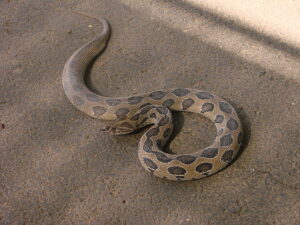Physical Address
23,24,25 & 26, 2nd Floor, Software Technology Park India, Opp: Garware Stadium,MIDC, Chikalthana, Aurangabad, Maharashtra – 431001 India
Physical Address
23,24,25 & 26, 2nd Floor, Software Technology Park India, Opp: Garware Stadium,MIDC, Chikalthana, Aurangabad, Maharashtra – 431001 India

Climate change, with its cascading effects on ecosystems and human societies, is increasingly influencing public health in India in unexpected ways. One alarming trend is the rise in snake bite cases across the country. Multiple reports in 2024 from different states like Bihar in East India and Assam, Mizoram in Northeast India talk about the rising cases of snake bites. Some reports directly connect it with climate change as changing weather patterns disrupt habitats, snakes and humans are coming into closer contact, leading to more frequent and often fatal encounters.
According to the central government statistics, nearly half of all snakebite deaths globally in a year take place in India, which is as high as 50,000, and the majority (around 90%) of snake bites are caused by the “big four” venomous snakes: the common krait, Indian cobra, Russell’s viper, and saw-scaled viper. The government also admits that while the administration of polyvalent anti-snake venom (ASV), which contains antibodies against these species, is effective in 80% of cases, challenges such as a lack of trained personnel and adequate healthcare facilities continue to impede effective treatment for snakebite victims.
Rising Temperatures and Shifting Habitats
India’s average temperature has risen by around 0.7°C between 1901 and 2018, with predictions of further increases. This warming trend is altering the habitats of many snake species, forcing them to move closer to human settlements in search of suitable environments. For instance, rising temperatures have been linked to increased activity in species such as the Indian cobra, Russell’s viper, and common krait, all of which are highly venomous and responsible for the majority of snake bite cases in India.
A study published in the journal Lancet Planetary Health predicted that by 2070, many venomous snake species are expected to lose suitable habitats due to climate change and some species, particularly those that pose high risks to public health, may find new areas to inhabit. Countries like Niger, Namibia, China, Nepal, and Myanmar could see an influx of these species from neighboring regions, the study said. Increased climatically suitable areas, combined with socioeconomic factors such as low income and high rural populations, will likely make regions in Southeast Asia and Africa—including Uganda, Kenya, Bangladesh, India, and Thailand—more vulnerable to snakebites, impacting both human and veterinary health, it added.
Another study by some local researchers from India, which is yet to peer-reviewed, found that future climate scenarios suggest a significant loss of suitable habitats for the “Big Four” snake species in India. The study added that their range is expected to shift towards northern and northeastern states like Assam, Manipur, Haryana, and Punjab, increasing public health risks in these regions due to greater overlap with agricultural and urban areas.
Impact of Erratic Weather Patterns
Erratic weather patterns, including unseasonal rainfall and extended dry spells, are another consequence of climate change. Heavy rains and flooding can drive snakes out of their natural habitats, bringing them into homes, agricultural fields, and other populated areas. In contrast, prolonged droughts can lead to decreased prey availability in forests, pushing snakes to hunt in human-dominated landscapes. For instance, the 2018 floods in Kerala saw a significant rise in snake bites as displaced reptiles sought refuge in flooded residential areas.
Need for Awareness and Adaptation
Addressing the growing risk of snake bites in a changing climate requires a multi-pronged approach. Raising awareness about preventive measures, such as wearing protective clothing and using nets around sleeping areas, can help reduce incidents. Additionally, improving healthcare infrastructure and ensuring the availability of antivenom in vulnerable regions are crucial steps. Training healthcare workers in snake bite management and promoting research on venom and treatment options can further enhance preparedness.
The rise in snake bite cases is a stark reminder of the complex and far-reaching impacts of climate change on human health and safety. As India grapples with the twin challenges of climate change and biodiversity loss, proactive measures are essential to protect both human and animal populations. Understanding and addressing this issue is not just a matter of public health, but also a critical step in building resilience against the growing threats posed by our changing environment.
References:
https://pib.gov.in/PressReleaseIframePage.aspx?PRID=2013803
https://pib.gov.in/PressReleasePage.aspx?PRID=1809123
https://www.sciencedirect.com/science/article/pii/S2590171021000059
https://www.thelancet.com/journals/lanplh/article/PIIS2542-5196(24)00005-6/fulltext
Tracking Russell’s vipers in rural Karnataka unravels their behaviour
https://papers.ssrn.com/sol3/papers.cfm?abstract_id=4904070
https://www.bbc.com/news/world-asia-india-45300506
Banner image: Russell’s Viper (By AChawla – Own work, CC BY-SA 3.0, https://commons.wikimedia.org/w/index.php?curid=9778967)